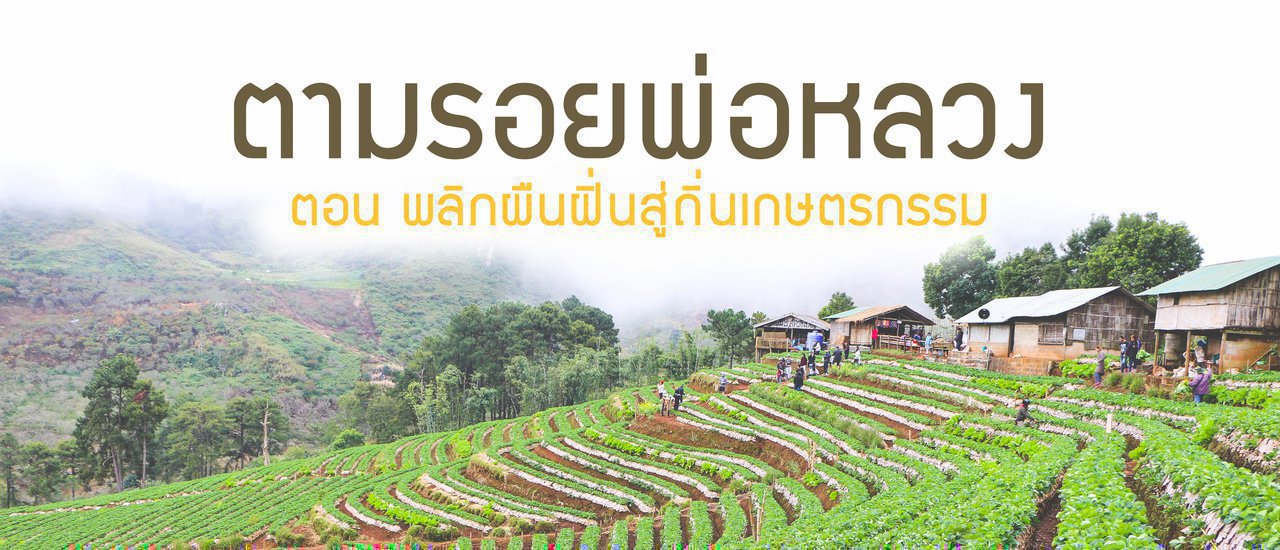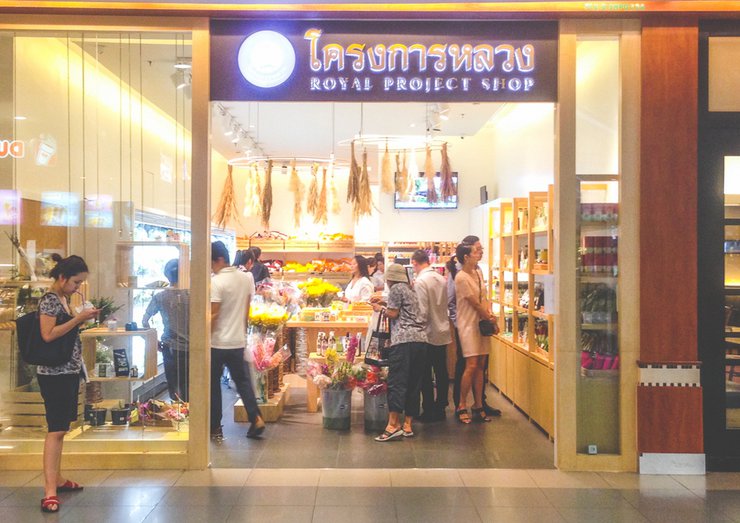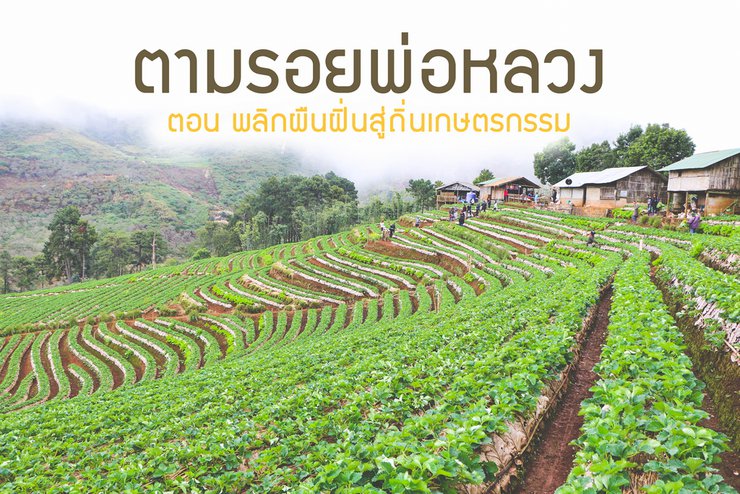
The Royal Project Shop is a retail outlet that sells agricultural products and handicrafts from over 25,000 farming households residing in mountainous regions across various provinces. These products include vegetables, fruits, ornamental flowers, herbs, tea, Arabica coffee, mushrooms, various field crops, processed products, and handicrafts created by hill tribe women within the Royal Project.

A familiar and trusted mini-supermarket that guarantees quality, freshness, and safety. It also supports local farmers by providing them with a stable income and improving their quality of life.

The Royal Project Shop operates under the guidance of the Royal Project, which systematically promotes and develops quality standards, from production on the mountain to distribution channels. This is basic information about the Royal Project Shop that many people may already know. However, few people know the origin and main reason for the establishment of this shop. We ourselves are also unaware.

The origins of the Royal Project and its impact on the lives of hill tribe farmers.

Our journey in the footsteps of the King led us to Chiang Mai, the province where the first Royal Project was established at the Ang Khang Royal Agricultural Station in Fang District.

The Chiang Mai atmosphere on that day was filled with rain clouds covering the entire area, and light rain fell intermittently. Combined with the cold December wind blowing through, the entire journey felt very cold and humid.

After collecting your luggage, proceed to the Avis Rent A Car counter, conveniently located near the baggage claim area and exit. You can pre-book and pay for your rental online or pay upon arrival. However, pre-payment is recommended for a more affordable rate.

The next step is to present your driver's license and credit card to the staff for verification. They will then place a hold on your credit card as a security deposit for the rental. This hold will be released approximately 15 days after the car is returned. Once the paperwork is complete, you can proceed to the nearby parking lot to collect your vehicle.

Due to our last-minute booking, only a pickup truck was available. However, this was not an issue as the powerful engine made climbing the mountain effortless.

Once ready, the journey begins with the first stop being lunch at Saneh Doiluang Restaurant, located on the bypass road in Chiang Dao District. The journey takes approximately 1 hour and 30 minutes. If you visit the restaurant when the sky is clear, you will be able to see the view of Doi Luang Chiang Dao.

After lunch, we continued our journey in the midst of a light rain. From Chiang Dao district, there are two routes to Doi Ang Khang. The first route (gray line) is Chiang Dao district - Fang district, a distance of approximately 90 kilometers. The last 5 kilometers of this route are uphill and quite steep, making it unsuitable for drivers who are not confident or unfamiliar with the route, especially during rain or heavy fog.

Route 2 (blue line) is from Chiang Dao District to Ban Arunothai, a distance of approximately 90 kilometers. This route is not steep but has many curves. We chose the second route because it is easy to drive and the scenery along the way is very beautiful.

The final 20 kilometers of the journey involved an uphill climb. On that particular day, the fog was extremely dense, and it became even thicker as we ascended. At times, visibility was limited to just 3 meters, making the drive quite hazardous. As a result, we were only able to maintain a speed of 20-40 kilometers per hour.

The journey from Chiang Dao to Ang Khang typically takes around 1.5 hours. However, on that particular day, it took us 2.5 hours. Despite the delay, we arrived at our accommodation safely.

After checking in and settling into our accommodation, we drove to a restaurant near the Ang Khang Royal Agricultural Station for dinner. We chose Ting Ting Restaurant, which is known for its signature dishes such as pork knuckle and Yunnan steamed buns.

And braised shiitake mushrooms in soy sauce

Conclude with a cup of hot milk to raise your body temperature before bed.

The next morning, we woke up around 5:00 AM to drive to the Mon Son viewpoint to watch the sunrise and the sea of mist. However, the mist was still thick and widespread, just like the previous evening.

We waited at a roadside restaurant, hoping the fog would clear. The temperature was around 15 degrees Celsius, making it cold and humid. We sat near a charcoal stove to warm ourselves and ordered hot milk to drink while we waited.

After nearly an hour, the fog showed no signs of clearing, and I began to lose hope. I decided to drive back down to continue on to the strawberry farm in Ban Nor La.

The fog grew thicker as we approached, and the strong wind blew the mist onto us, soaking us through. We sought shelter in the house of a nearby resident, the owner of a strawberry plantation.

The household bustled with activity as they meticulously sorted the remaining strawberries from the royal project delivery, preparing them for packaging and sale to tourists.

Every morning, children help their grandparents harvest strawberries for the Royal Project. The harvest season is once a year, from December to February. During the off-season, they plant legumes to enrich the soil.

According to Mae Uai and Por Uai, in the past, opium was cultivated in this area and sold to China. Chinese merchants would come to the village to purchase the opium. Villagers would clear the forest during the dry season to prepare the land for opium cultivation during the rainy season. The opium was then harvested during the winter.


"King Bhumibol Adulyadej and Queen Sirikit visited the residents of Pak Phai Village in Fang District, Chiang Mai Province. While passing through Doi Ang Khang, they observed that the majority of the hill tribe residents were engaged in opium cultivation, which not only perpetuated their poverty but also destroyed the vital forest resources of the headwaters, jeopardizing the ecological balance and potentially causing damage to other parts of the country."

"The King observed that the area had a cold climate, extensive opium cultivation, no forests, and relatively flat terrain. He was also aware that the hill tribe people earned the same amount of money from opium as they did from growing local peaches. Additionally, he knew that the Faculty of Agriculture at Kasetsart University's experimental cold-climate fruit station had experimented with grafting techniques for Western peaches. As a result, he donated 1,500 baht of his personal funds to purchase land and orchards from the hill tribe people in a portion of Doi Ang Khang."

"In 1969, the Royal Project was established as a personal project of His Majesty the King. His Royal Highness Prince Bhisadej Rajani was appointed as the Chairman of the Royal Project Foundation. The project served as a research and experimental station for various temperate crops, including fruits, vegetables, and flowers. The aim was to provide a model for hill tribe farmers to cultivate these crops as a source of income. Subsequently, His Majesty the King bestowed the name "Ang Khang Royal Agricultural Station" upon the project."

Following that, villagers began to switch from opium cultivation to cold-weather crops. Initially, Mae Ui and Por Ui's land was used to grow roses for the Royal Project, before transitioning to the popular Royal Strawberry 80 variety.

The income generated from the sale of agricultural products has improved the living standards of villagers, enabling them to achieve self-sufficiency and access to better education and healthcare. Once a land of opium cultivation, the region has gradually transformed into a thriving agricultural hub. This remarkable change was not driven by royal authority, but rather by the King's compassionate heart and his unwavering commitment to the well-being of all his subjects.

The sentence is already in English and does not require translation.
As I sat talking with Ma-Uai and Pa-Uai, I noticed Nong Phong, or D.Ch. Phong Nai Man, a 12-year-old boy and the nephew of Ma-Uai and Pa-Uai, looking at pictures in an old notebook.

Approaching the child, we requested to see the pictures. The notebook was filled with portraits of His Majesty King Bhumibol Adulyadej and members of the royal family. The child, who started collecting these pictures at the age of nine, now has a total of three albums: one notebook and two folders. We asked the child why they enjoyed collecting these pictures.

The young girl shared that she has known the King since she could remember. Her grandfather, who had previously received royal assistance, recounted the King's benevolence towards the villagers, instilling in her a deep love and admiration for him. Inspired by these stories, she began collecting his portraits, a testament to her enduring respect. This encounter was a heartwarming highlight of our journey.

We continued our journey to the Khop Dong village, located near the strawberry farm, to find the home of "Ja Mo," a former leader of the Lahu Na tribe who once welcomed His Majesty King Bhumibol Adulyadej and Her Majesty Queen Sirikit.

We parked our car at Ban Khop Dong School, near the Sen Silap shop, a student handicraft center. Inside, there is a wide variety of student-made souvenirs to choose from, mostly made from Ibu Kae grass, a sacred grass of the Lahu tribe.

We met with Kru Nan, the teacher in charge of Ban Khop Dong School, who was helping students take care of the shop. We asked her about Ban Ja Mo and learned that Ja Mo had passed away two years ago. Kru Nan offered to take us down to the village to visit Ja Mo's house.

This new house was built to replace the old one that was demolished after the doctor's death.

We met with Uai Nalo, the wife of Chamorro, who also received the royal procession.

In front of Uai's house, there is a portrait of King Bhumibol Adulyadej from his visit to the Khop Dong villagers in 1969. A picture of a shaman also hangs there.

The teacher informed us that His Majesty first visited the area in 1966, followed by several subsequent visits. These visits aimed to understand the villagers' living conditions and identify appropriate ways to improve their quality of life.

The photograph that Aui is holding is from the Angkhang Royal Agricultural Station website. It depicts a man in traditional attire, presumably a shaman, presenting an offering to His Majesty King Bhumibol Adulyadej. The setting and composition of the photograph resemble the one hanging on the wall.

The circular bamboo-enclosed space near Uei's house is the Laheu people's traditional dance ground, known as "La Ten Ka Kee." This dance was once performed as an offering to His Majesty King Bhumibol Adulyadej.

We then walked back up from the village to visit the museum that tells the story of the Lahu people's way of life.

The museum building is situated on a hill near the school.

The interior displays a portrait of His Majesty King Bhumibol Adulyadej during his visit to the residents of Khop Dong Village.

The museum showcases various tools and equipment used in daily life, as well as unique handicrafts that are emblematic of the Lahu people's cultural heritage.

The journey then continued to the 2000 Rai Tea Plantation, a renowned source of premium tea at the Angkhang Royal Agricultural Station.

In addition to its scenic beauty, this location also empowers local residents by providing them with employment opportunities.

From the 2000 Rai Tea Plantation, we continued our journey to the Angkhang Royal Agricultural Station.

Our first stop was the helicopter landing pad.

To locate the helipad, as shown in the image below, the large bush on the right side remains standing next to the helipad to this day.

The next stop is the 80th Birthday Anniversary Garden, or Suan 80, a large flower garden where various flower species are in full bloom, showcasing their beauty.

Notably, over 700 cherry blossom trees, with saplings imported from Japan in 2007 and Taiwan in 2008, have begun to bloom in succession since early December and will continue to blossom until January.

Across from the garden, there is a Royal Project shop, which sells souvenirs and agricultural products sourced from local villagers.



The next stop is the plum orchard, one of the Royal Project's demonstration plots that serves as a model and provides opportunities for local people to learn and experiment with growing their own plums.

Once the villagers saw the benefits and income generated from alternative crops, they abandoned opium cultivation. This marked a pivotal shift from opium fields to agricultural lands.

The plum blossoms bloom between December and January, making it an ideal time for photography. The fruit can be harvested from March to April.

The final destination of our journey was the village of Pang Ma, located near the plum germplasm collection orchard, where the revered King Bhumibol Adulyadej once visited the local residents.

This journey following in the footsteps of the King has deepened our understanding of the objectives behind the Royal Project's establishment. We learned about its history through firsthand experience at the actual locations and interacted with local residents, gaining a deeper appreciation for the King's immense kindness and compassion towards them.
The King is like a great traveler who journeys far and wide to bestow his royal grace and kindness upon his people equally and fairly, ensuring their well-being, no matter how remote or difficult the location.
"Join us in supporting good deeds, following in the footsteps of His Majesty the King, by "Jetradar.co.th" and "Readme.me"
Source: www.royalprojectthailand.com and www.angkhangstation.com
Note: If there are any inaccuracies in the explanation or use of royal language, please feel free to suggest corrections so that we can make the information as accurate, appropriate, and complete as possible.
LOVE & LIFE IS A JOURNEY
Friday, October 4, 2024 3:08 PM





















